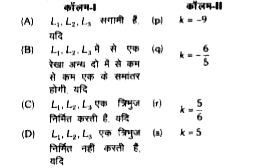यदि e[exeyeyex]=[1111] तब x और y के मान है
−1,−1
1,1
0,0
1,0
The correct Answer is:A
Step by step video, text & image solution for यदि e[(e^(x),e^(y)),(e^(y),e^(x))]=[(1,1),(1,1)] तब x और y के मान है by Maths experts to help you in doubts & scoring excellent marks in Class 12 exams.
Topper's Solved these Questions
- BOOK - ERRORLESS HINDICHAPTER - सारणिक तथा आव्यूह EXERCISE - EXERCISE262videos
सारणिक तथा आव्यूह
- BOOK - ERRORLESS HINDICHAPTER - सारणिक तथा आव्यूह EXERCISE - JEE ADVANCED MORE THAN ONE CORRECT ANSWERS66videos
सारणिक तथा आव्यूह
- BOOK - ERRORLESS HINDICHAPTER - सारणिक तथा आव्यूह EXERCISE - Solved Multiple Choice Questions ( रैखिक समीकरणों का निकाय कुछ विशेष सारणिक, सारणिक का अवकलन तथा समाकलन)50videos
सारणिक तथा आव्यूह
- BOOK - ERRORLESS HINDICHAPTER - सरल रेखा EXERCISE - JEE ADVANCE (Matrix Match type questions)4videos
सरल रेखा
Similar Questions
∣∣ ∣ ∣∣111cos(nx)cos(n+1)xcos(n+2)xsin(nx)sin(n+1)xsin(n+2)x∣∣ ∣ ∣∣ निर्भर नहीं करता है
04:20View Solutionसारणिक ∣∣ ∣∣abaα+bbcbα+caα+bbα+c0∣∣ ∣∣=0 यदि
View Solutiona का वह मान जिसके लिये समीकरण निकाय a3x+(a+1)3y+(a+2)3z=0,ax(a+1)y+(a+2)z=0,x+y+z=0 का एक अशून्य हल है
03:24View Solution 07:54View Solution
07:54View SolutionIf ex+ey=ex+y , prove that dydx=−ex(ey−1)ey(ex−1) or, dydx+ey−x=0
03:22View SolutionDraw the graph of y=loge(−x),−logex,y=|logex|,y=loge|x| and y=|loge|x|| transforming the graph of y=logex.
04:50View Solutionयदि ex+ey=ex+y हो,तो सिद्ध कीजिए कि dydx=−ex(ey−1)ey(ex−1)
03:36View SolutionIf the curve satisfying (1+exy)dx+exy(1−xy)dy=0 passes through (1,1) then 9+y(2)e2y(2)−e is equal to-
02:15View SolutionIf x=ey−e−yey+e−y show that y=12loge(1+x1−x)
00:52View Solutionयदि xloge(logex)−x2+y2=4⋅y>0), तो dydx का मान , x= e, पर बराबर है
05:39View SolutionIf ex+ey=ex+y, prove that :
dydx=−ex(ey−1)ey(ex−1).10:39View Solutionযদি x=ey−e−yey+e−y হয়, তবে দেখাও যে, y=12loge1+x1−x।
04:01View SolutionIf y = ex+e−xex−e−xthen is equal to...
02:19View SolutionDraw the graph of y=loge(−x),−logex,y=|logex|,y=loge|x| and y=|loge|x|| transforming the graph of y=logex.
01:51View SolutionIf ex+ey=ex+y , prove that dydx=−ex(ey−1)ey(ex−1) or, dydx+ey−x=0
03:03View Solution

